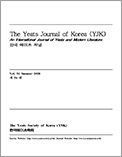ISSN : 1226-4946(Print)
ISSN : 2288-5412(Online)
The Dancer and the Heart’s Desire: W. B. Yeats and the Theatre of Modernity
Reader in Theatre History, Department of Theatre and Performance, Goldsmiths, University of London
Abstract
Yeats’s image of the dancer is selected precisely for its conceptual fluidity asan embodiment. The dancer/dance paradoxically symbolises that which is not merelysymbolic, it evokes an art, a social practice, and, as ‘brightening glance’, aninter-subjective physical action, experientially felt at the moment of participation. If theleaf, the blossom or the bole can act as symbols of the Chestnut tree they do so asmetonyms, parts of the whole whose power of representation derives from shared,contiguous being. The dance, likewise, may function as an artwork but does so as adimension of nature and culture, wherein the subject must labour, in despair or pleasure.
댄서와 가슴의 욕망: W.B. 예이츠와 현대극
벤 라비타스
런던대학교, 연극공연학과, 연극사 교수
초록
예이츠는 개념적 유동성을 정확하게 구체화시키기 위해서 댄서의 이미지를 선택했다. 댄서/댄스는 역설적으로 단순히 상징적인 것만을 상징하는 것이 아니라,예술, 사회적 관습을 상기시키고, “번쩍이는 시선”으로서 참여의 순간에 경험적으로 느끼는 상호주관적 육체적 반응을 나타낸다. 잎, 꽃 혹은 줄기는 밤나무를 상징한다면,이것들은 메토님으로서 그런 역할을 하는데, 전체의 부분들의 표현의 힘은 공통적으로공유되는 것에서 유래한다. 댄스는 마찬가지로, 예술작품으로서 기능할 한다면, 자연과문화의 차원에서 그런 것인데, 이때 댄서는, 고통이든 기쁨이든, 최선을 다해야 한다.










